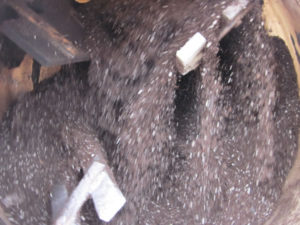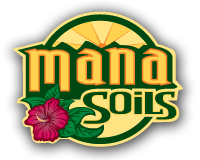 With Mana Soils you need nothing else—no top soil, no manure, no compost, no fertilizer, no additives of any kind. Our soils are the power of nature unified in one source—all that plants and trees need to grow well. But that’s not all that’s special about Mana Soils. All the amendments in our family-held formula are tested by the Organic Materials Review Institute (OMRI) or equivalent and certified organic. There’s more: we don’t stop there as all our materials are derived from sustainable and, with the exception of coconut coir, from regional sources. Also, there is no peat in our products. A little-known fact that is starting to get more press is that the use of peat has become an environmental nightmare. Briefly peat bogs are an important ecosystem in the earth’s overall health, and they are being destroyed not just by climate change and pollution, but the over-cutting of peat for gardening and farming. So take a closer look at Mana Soils.
With Mana Soils you need nothing else—no top soil, no manure, no compost, no fertilizer, no additives of any kind. Our soils are the power of nature unified in one source—all that plants and trees need to grow well. But that’s not all that’s special about Mana Soils. All the amendments in our family-held formula are tested by the Organic Materials Review Institute (OMRI) or equivalent and certified organic. There’s more: we don’t stop there as all our materials are derived from sustainable and, with the exception of coconut coir, from regional sources. Also, there is no peat in our products. A little-known fact that is starting to get more press is that the use of peat has become an environmental nightmare. Briefly peat bogs are an important ecosystem in the earth’s overall health, and they are being destroyed not just by climate change and pollution, but the over-cutting of peat for gardening and farming. So take a closer look at Mana Soils.
Feather Meal
Feather meal is produced through the poultry slaughter industry. This product is very high in Nitrogen, and has a slow decomposition rate (avg 3-4 months). 7-12% Nitrogen. Feather meal increases green leaf growth, as well as activates the organic matters decomposition.
Alfalfa Meal
Is used to add organic matter to soil. Alfalfa meal has a level amount of nutrients, and very high levels of trace minerals. This amendment has fatty acids which is a growth stimulant during the vegetative state of the plant. Decomposition rate is immediate. Release time is 1-4 months. Alfalfa meal provides nitrogen to nutrient deficient soils. N/P/K 2/1/2
 Kelp Meal
Kelp Meal
Is a beneficial source of micro nutrients. Kelp meal has an insignificant amount of nitrogen, phosphorus, potassium. Although when combined with fish meal it adds N/P/K. Kelp meal has a slow decomposition rate (3-4 months).
Soybean Meal
Is a solid residue bi-product, created after grinding the soybean to extract soybean oil. It is derived from soybeans and used as a soil amendment. Soybean meal is prized for its high nitrogen (7 percent) content and as a source of phosphorous (2 percent). Like alfalfa meal, it is particularly beneficial to nitrogen-loving plants, such as roses. N/P/K 7/2/1
Green Sand
Has become a beneficial source of potassium. The average decomposition rate is (3-4 months). Green sand is mined from deposits of minerals that were originally part of the ocean floor. Green sand improves the physical properties of the soil. This product is more valuable as a soil condition than a source of plant nutrition. Green sand contains micro-pores for enhanced nutrient and water retention. Using green sand can improve yields by up to 15 %. N/P/K 0/0/3
Rock Phosphate
Is a sedimentary rock witch contains high amounts of phosphate bearing minerals. Rock phosphates are a critical ingredient in building soil phosphorus. These phosphates help build a soil that is capable of producing nutrient rich, high yield foods. These phosphates are a slow release nutrient which is needed for healthy fruiting. N/P/K 0/3/0
Glacial Rock Dust
Glacial rock dust contains a broad range of trace minerals. A natural mineral product produced by thousands of years of glacial action. A wide variety of rocks containing a spectrum of trace minerals are collected and pulverized by the expansion/contraction action of the glacier. This product replaces key soil elements, reversing soil depletion. Excellent source of readily available calcium, iron, magnesium, and potassium. As well as trace elements, and micronutrients. This product Increases the availability of phosphorous.
Fish Meal
The balanced amino acids composition of fish meal compliments and provides a synergistic effect with other vegetable proteins. This promotes a rapid growth in a vegetative state. High in nitrogen and phosphorus gives a medium decomposition rate for all season release. N/P/K 9.5/3/0
Fish Bone Meal
Excellent source of phosphorus, and calcium with a small amount of nitrogen. A natural by-product of the fishing industry, fish bones are cooked and ground to create a high phosphorus fertilizer perfect for flowering and fruiting plants. This amendment encourages healthy roots systems. Use fish bone meal as a substitute for regular bone meal. N/P/K 3/16/0
Seabird Guano
This Guano is a beneficial ingredient. The de composting microbes help control nematodes and work as a compost activator. This is a fast-acting, natural amendment with high levels of available nitrogen & phosphorus, and lesser amounts of potassium. N/P/K 12/12/2.5
Worm Castings
Vermi compost is the process of composting using earthworms. This ingredient has low levels of contaminants and has high saturation of nutrients. Worm castings are water soluble for immediate release of nutrients. Worm castings is one of natures most abundant and effective fertilizers. A rich, odorless, all natural organic product. N/P/K 1/0/0.
Pumice
White pumice is a volcanic rock which will float on water. By using this ingredient it creates a living environment for beneficial micro bacteria. Because of its lack of density it creates air pockets in the soil. Pumice will hold micronutrients creating a flourishing abundance of life resulting in healthy root development as well as timed releases of nutrients.
Bio-Char
This high potassium ingredient will elevate the PH. Bio-char improves water quality. This product has amazing abilities to:
- Reduce nutrient leaching
- Reduces soil acidity
- Less irrigation and fertilizer requirements
- Holds water and nutrients
- Stops leaching of nitrates
- Reduces carbon imprint (4month case study)
Aged Sawdust
Aged sawdust is crucial to building up the organic matter in the soils composition. It is a high carbon. Slow decomposition of this matter provides water retention and a beneficial environment for micro bacteria.
Compost
Is organic matter that has been decomposed and recycled as a soil amendment. Compost is a key ingredient in organic farming. Compost can be rich in nutrients. It is used in gardens, horticulture and agriculture. The compost itself is beneficial for the land in many ways, including as a soil conditioner, and fertilizer. It adds vital humus or humic acids , and as a natural pesticide for soil.
Live Earth Humates
A humate is de composted organic matter. Over 70 million years old Live Earth Humates is the same as a peat bogs except 69 million years older. Humates are high in humic acids and contains larger quantities of trace minerals. This product increases the plants ability to extract nutrients, stimulates root growth, and helps overcome stresses (pests, dry weather, cuttings etc.). When applied to soil it activates micro organisms that produce nitrogen. Reduces need for N/P/K additives. Humates provide nutrients through micro organisms because of the healthy environment it produces.
Perlite
Is volcanic glass that is heated to a point of expansion. When it is heated it becomes light and provides aeration in the soil composition. When used as an amendment it has high permeability / low water retention and helps prevents soil compaction.
